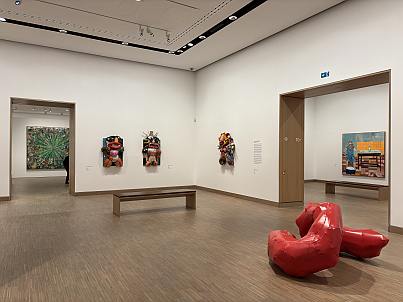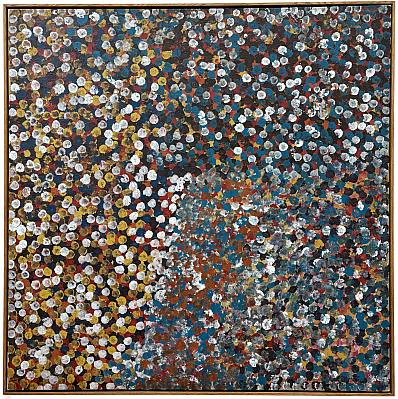Review of Art Exhibition
The review below was created specifically for this website. Any external links are for information only and such content is not the responsibility of the authors.
16.02.2024 - 18.08.2024 Exhibition 'The Beauty of Diversity' at the ALBERTINA Modern, Vienna
The ALBERTINA museum has a collection of over 1.2 million artworks, over 60,000 of which are contemporary art. The exhibition 'The Beauty of Diversity' deliberately pushes the boundaries of that collection by highlighting works from women and LGBTQIA+ artists, people of color, aboriginal artists, and autodidacts.
 The ALBERTINA Modern provides an excellent 5-minute 'video walk through' of the exhibition, commented (in German) by the curator Angela Stief. The key to a a wonderful visit is being prepared to be shocked. Shocked by some images, yes, but mainly shocked by what you don't know and who you don't know.
The ALBERTINA Modern provides an excellent 5-minute 'video walk through' of the exhibition, commented (in German) by the curator Angela Stief. The key to a a wonderful visit is being prepared to be shocked. Shocked by some images, yes, but mainly shocked by what you don't know and who you don't know.
Shock arises from broken expectations: social mores violated, visual conventions side-lined, Western self-satisfied supremacies ignored. Gender and identity statements are central to many of the artworks, but also sublime disregard for occidental modes of thinking, as exemplified by some Indigenous Australian artworks discussed below.
In particular, concerning art from Australia, artworks from two Indigenous Australian women artists, Emily Kame Kngwarreye and Nyunmiti Burton, are shown juxtaposed with works by two women European artists Soli Kiani and Elena Koneff. Emily Kame Kngwarreye's life story has been recounted in a number of heavyweight books, most recently in the catalogue for the early-2024 retrospective exhibition at the National Gallery of Australia, a show that will travel to the TATE Modern in 2025. The NGA's catalogue's introduction notes that Emily Kame Kngwarreye (spelled Emily Kam Kngwarray in that catalogue) grew up in central Australia with little or no contact with occidental art, religion, or technology, but with her own strong sense of life and art which was eventually lauded in Western art circles.
The unprecedented trajectory of Kngwarray’s recognition and fame as an artist is now well known, way beyond the country of her origins. Kngwarray’s power and cultural authority is outstandingly revealed in the works of art themselves. However, critical responses to her work have often been framed by definitional categories derived from western artistic traditions—tropes of modernism and abstract expressionism. The history of western art was confounded by its encounter with a continuing cultural tradition much more ancient than any that has sprung from European soil. [1]
 This confounding/collision is explained in more detail later in the NGA catalogue, but is also hinted at by the titles of three works by Emily Kame Kngwarreye from the ALBERTINA Modern collection: 'Kame Awelye', 'Awelye' and 'Untitled (Alhalkere)' (the work shown here, from 1992). In her language, Kam means the tubers of an important food plant Dioscorea transversa after which the artist is named, Awelye refers to painted designs on the body, used in many Indigenous women's ceremonies, but also referencing the broader content of a ceremony and the associated body of knowledge, and Alhalkere is the name of her whole country. Kngwarreye once famously replied to an enquiry about the inspiration for an artwork by saying it represented "the whole lot", the entire essence of Alhakere. That is, her painting(s) are inspired by her country, her life, and her identity.
This confounding/collision is explained in more detail later in the NGA catalogue, but is also hinted at by the titles of three works by Emily Kame Kngwarreye from the ALBERTINA Modern collection: 'Kame Awelye', 'Awelye' and 'Untitled (Alhalkere)' (the work shown here, from 1992). In her language, Kam means the tubers of an important food plant Dioscorea transversa after which the artist is named, Awelye refers to painted designs on the body, used in many Indigenous women's ceremonies, but also referencing the broader content of a ceremony and the associated body of knowledge, and Alhalkere is the name of her whole country. Kngwarreye once famously replied to an enquiry about the inspiration for an artwork by saying it represented "the whole lot", the entire essence of Alhakere. That is, her painting(s) are inspired by her country, her life, and her identity.
In contrast to such a holistic approach, explainable in occidental art-historic terms only after extensive research and experience, shown in an adjacent room are a series of photo-montage artworks by the Australian artist Tracey Moffatt, who metaphorically dissects and cunningly exposes gender stereotypes using exerpts from popular Australian 1960s movies (heavily influenced by Hollywood). Each montage is a singular window into a socially-constructed fantasy (i.e. lie) defining the proper role of women in Western civilization. It is said that the Jesuits famously believed that the first seven years of a child's life determine their adult lives, but with modern television and advertising supporting the gender stereotypes we may have shortened that.
The whole exhibition can be viewed as windows into diverse world-views, substituting or subverting the traditional socially-constructed constraints on (artists') identities.
What does the press have to say about the exhibition? Almost every article repeats the mantra of 'showing the huge depth and breadth of the Albertina collection' - which is true, but misses the point.
The StyleMate Journal ('offering inspiration from around the world for an aesthetic and meaningful lifestyle'
) comments that the exhibition gets its power from the 'juxtaposition of renowned artists who have always wanted to strain the canon and yet have become canonised, and new discoveries as well as those who irritate viewing habits, swim against the tide, shake the foundations of high culture
'.[2] The article emphasises that by confronting viewers with a wealth of works in extraordinarily different styles, contrasting to the accustomed 'stars' of the classical modern, the viewer experiences the dilemma of all modern art museums: how to preserve and present the past waves of art, yet be open (and open their collecting practices) to the agressively different? Just how difficult it is to be non-partisan, to stand aside from the usual '-isms' is inadvertently shown by another quote from the same article: '[The exhibition] explores the beauty of the grotesque, the impure and the repressed. The marginalised and the deviation from the norm become visible.
' [3] And why are all the descriptive terms negative?
The Vienna city news pages cite a quite different view when they quote Angela Stief, curator of the exhibition and director of the ALBERTINA Modern, as saying that:
'[Es] dreht sich [bei] ''The Beauty of Diversity'' um Widerstand, Empowerment und ''das Einstehen für Freiheit, die eigene Identität darzustellen''.' [4] [The 'Beauty of Diversity' is about resistance, empowerment and standing up for freedom to express one's own identity].
The Kunstmagazine Parnass art critic Paula Watzl is a 'glass half-empty' kind of person, saying
'Wer einen Blockbuster-Titel wählt, muss auch liefern. Das gelingt der ALBERTINA Modern mit der Schau 'The Beauty of Diversity' nur in Teilbereichen. Geboten wird herausragende Kunst, aber leider keine wesentliche Auseinandersetzung mit dem Diversity-Begriff. [If you choose a blockbuster title, you have to deliver. The ALBERTINA Modern's show 'The Beauty of Diversity' only partly succeeds. It offers outstanding art, but unfortunately no significant examination of the concept of diversity.]' [5]
For this reviewer, that statement is too simplistic: as if 'diversity' can be encompassed, catalogued, pigeon-holed, and filed 'ad acta' in one exhibition! For those privileged to see the 2024 Biennale di Venezia, where art diversity is invited into about a hundred buildings in the official Giardini, Arsenale, and around the whole city of Venice it is clear: Not even a city full of art can delimit diversity. Which is the whole point: Visitors can experience at the ALBERTINA Modern a taste of what they have been missing (or been denied) within the classical cannons of art.
Discovering the depths (or peaks) of diversity in contemporary art requires time, effort, and something of an 'Entdeckergeist' (explorer mentality). Old tomes on art history once provided chronogeographical 'maps' of world art (see [6] in print from 1962 to 1996, and [7] which pilloried [6]), but in most such overviews the art of LGBTQIA+ plus people of colour plus autodidacts plus Indigenous artists were invisible in the 'Here be Dragons' corners.
The 223-page catalogue of the exhibition, printed in German, provides some hints, but few references, towards re-constructing an inclusive map of art. Art historian and author Katharina Sykora offers in pages 12-25 eight various groupings of artists into kinds of (gender-based) dissent, whereas the curator Angela Stief divides the catalogue chapters into seven further sub-divisions (Obsession, Hybrid Forms, The Grotesque, Dream and Shock, Self-empowwerment, Black Art Matters, and Critique of Civilisation). The visitor is therefore left wondering: Where do I go from here? But at least that is a pro-active improvement compared to self-satisfied eurocentric omphaloskepsis. [8]
[1] See nga.gov.au/stories-ideas/emily-kam-kngwarray-an-artistic-revolution/
[2] See www.thestylemate.com/the-beauty-of-diversity-16-2-18-08-2024-albertina-wien/?lang=en
[3] Ibid.
[4] See wien.orf.at/stories/3245259/
[5] See www.parnass.at/news/diversitaet-ist-nicht-nur-schoen
[6] The endpapers in textbooks 'History of Art: A Survey of the Major Visual Arts from the Dawn of History to the Present Day
' by Janson H.W. et. al. (1962), 662-pages, Harry N. Abrams, Inc., New York., Accessed 14th July 2024 at https://archive.org/details/historyofartsurv00jans/mode/2up
[7] Nelson, S. Robert. (1997) 'The Map of Art History', The Art Bulletin, Vol. 79, No. 1 (March 1997), pp. 28-40. Accessed on 14th July 2024 at https://www.csus.edu/indiv/o/obriene/art192b/map%20of%20art%20history%20nelson.pdf
[8] Omphaloskepsis is derived from Greek roots for 'navel' and 'investigation', providing a wonderful substitute for the term 'navel-gazing' when the latter is too obviously insulting.
